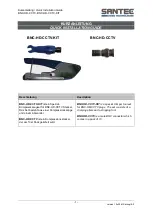
7
2.3 Modbus-RTU Description
2.3.1 RTU Framing
This gripper uses the standard Modbus-RTU protocol.
In RTU mode, the first field is the device address. The allowable characters transmitted for all
fields are hexadecimal 0 ... 9, A ... F. Networked devices monitor the network bus continuously,
including during the silent intervals. When the first field (the address field) is received, each device
decodes it to find out if it is the addressed device.
A typical message frame is shown in Table 2.1.
Table
2.1
RTU Framing (Function Code:0x06)
Slave Address
Function
Register address
Register data
CRC
01
06
01 00
00 01
49 F6
Slave Address:
The Slave address of the gripper.
The default is 1, you can also
modify it through
write different value to Slave Address register.
Function:
The Function Code field tells the addressed slave what function to perform. Includes read
or write registers function.
Register address:
Specifies which registers reference to be written.
Register data:
Specifies which value to be written. Each register (word - 16 bits) of the Modbus
RTU protocol is composed of 2 bytes (8 bits) from the Gripper.
CRC:
the CRC error-checking field contains a 16-bit value implemented as two eight-bit bytes. The
CRC field is appended to the message as the last field in the frame. The low-order byte of the field
is appended first, followed by the high-order byte. The CRC high-order byte is the last byte to be
sent in the message.
2.3.2 Supported Modbus Function Code
This griper uses MODBUS- RTU. The following function codes are currently supported:
03 (HEX): Read Holding Registers
06 (HEX): Write Single Register
10 (HEX): Write Multiple Registers
2.3.3 Register Mapping
The gripper’s Modbus-RTU registers
consist of two types of registers:
the basic control
registers
and
the
configuration registers
.








































